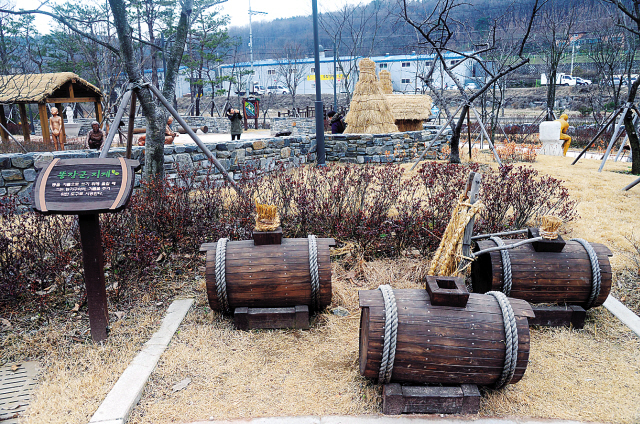Welcome to the holy grail of toilets
One eccentric man’s lifetime mission delves into the history of human waste disposal
By Korea HeraldPublished : April 2, 2013 - 19:36
The following is part of a series exploring unique museums, collections and the passionate collectors behind them. ― Ed.
The late Sim Jae-duck, then the mayor of Suwon, was elated when his city was chosen to host some of the 2002 World Cup games. However, when he was asked what he intended to do about updating the public restrooms in the city, the mayor was reportedly jolted into action to improve the quality and hygiene of the city’s public restrooms.
His dedication to the clean-up efforts of Suwon public restrooms earned him the nickname “Mr. Toilet,” a name that is more than fitting considering that Sim was actually born in an outhouse.
Sim dedicated his life to improving toilets and toilet culture, culminating in the establishment of the World Toilet Association in 2001, a nonprofit organization whose goal is to improve sanitation conditions for people around the world through fund raising, technology and education.
The late Sim Jae-duck, then the mayor of Suwon, was elated when his city was chosen to host some of the 2002 World Cup games. However, when he was asked what he intended to do about updating the public restrooms in the city, the mayor was reportedly jolted into action to improve the quality and hygiene of the city’s public restrooms.
His dedication to the clean-up efforts of Suwon public restrooms earned him the nickname “Mr. Toilet,” a name that is more than fitting considering that Sim was actually born in an outhouse.
Sim dedicated his life to improving toilets and toilet culture, culminating in the establishment of the World Toilet Association in 2001, a nonprofit organization whose goal is to improve sanitation conditions for people around the world through fund raising, technology and education.

In order to commemorate the World Toilet Association and to further spread the message of the importance of toilets throughout the world, Sim converted his 30-year-old house to be built in the shape of a toilet and named it “Haewoojae.” The project was completed in 2007 and Sim lived there with his family until he passed away two years later of prostate cancer.
Following Sim’s death in 2009, Haewoojae was donated to the city of Suwon following his will, and the building was later converted into a museum. The Toilet Culture Museum, better known as Mr. Toilet House, was officially opened in 2010 and stands as a showcase of the history and culture of toilets in Korea.
“He (Sim) used to say that every human being has the right to have access to sanitary, clean toilets. This was his philosophy,” said museum manager Lee Youn-sook. “Toilets are as important as food intake,” she said, going on to explain how approximately 40 percent of the world population does not have ready access to sanitary restrooms, making the population vulnerable to diseases.
Mr. Toilet House houses documents, photos and various historical artifacts regarding the history of toilets and restrooms in Korea, as well as the conditions of pubic toilets in less developed nations. The Toilet Culture Park, established last year, surrounds the giant toilet-shaped house. The area certainly does not boast a typical afternoon-walk-in-the park atmosphere: Rather, it is an opportunity for people to view sights that unveil the blunt, humorous and at times harsh truths about the history and culture of restrooms in Korea.

The park has examples of Korean toilets from the Baekje, Silla, Goryeo and Joseon periods as well as modern-day toilets with humorous statues and sights including a maehwateul, portable toilet for the king, and the “eco-friendly toilets” of Jeju Island where people relieved themselves into a pig pen.
The park is a popular destination for tourists and is even a destination that is included on many Suwon city tour buses. Visitors can take a stroll around the small surrounding park and blush at the varying statues of people relieving themselves while letting out embarrassed laughter as one learns about the country’s intriguing culture regarding human waste.
“People used to say that the king’s excretions resembled a Japanese apricot flower, so the king’s portable toilet, was often referred to as the Japanese apricot bowl,” said Lee. “It was said that court staff actually checked the color, smelled and even tasted the king’s poop to check on his health.”
“Many Koreans, many Asians also thought that poop was the color gold,” she said. “They used to think that if they saw golden poop in their dream, it was a sign of good fortune.”
Lee went on to explain the many traditional superstitions, including how Koreans believed that a child’s bed-wetting problem could be cured by sending the child out to beg for salt from the neighbors ― it was thought that the shame of having everyone know about the problem would stop the bed wetting.
A visit to Mr. Toilet House is certainly not a typical museum experience and will undoubtedly have visitors engaging in unconventional bathroom chit chat.
“I think toilets are very cathartic, a place for both physical and mental release,” Lee said smiling. “I know that talking about going to the bathroom is a very personal matter, but not here because after all, this is a toilet museum.”
■ Mr. Toilet House
(031) 271-9777
● Location: Jangan-ro 458-9, Jangan-gu, Suwon, Gyeonggi Province
● Hours: Tuesday-Sunday from 10 a.m.-6 p.m. (March through October) and 10 a.m.-5 p.m. (November through February)
● Admission: Free
● For more information, visit www.haewoojae.com
By Julie Jackson (juliejackson@heraldcorp.com)
-
Articles by Korea Herald








![[Graphic News] More Koreans say they plan long-distance trips this year](http://res.heraldm.com/phpwas/restmb_idxmake.php?idx=644&simg=/content/image/2024/04/17/20240417050828_0.gif&u=)
![[KH Explains] Hyundai's full hybrid edge to pay off amid slow transition to pure EVs](http://res.heraldm.com/phpwas/restmb_idxmake.php?idx=644&simg=/content/image/2024/04/18/20240418050645_0.jpg&u=20240419100350)






![[From the Scene] Monks, Buddhists hail return of remains of Buddhas](http://res.heraldm.com/phpwas/restmb_idxmake.php?idx=652&simg=/content/image/2024/04/19/20240419050617_0.jpg&u=20240419175937)

![[KH Explains] Hyundai's full hybrid edge to pay off amid slow transition to pure EVs](http://res.heraldm.com/phpwas/restmb_idxmake.php?idx=652&simg=/content/image/2024/04/18/20240418050645_0.jpg&u=20240419100350)

![[Today’s K-pop] Illit drops debut single remix](http://res.heraldm.com/phpwas/restmb_idxmake.php?idx=642&simg=/content/image/2024/04/19/20240419050612_0.jpg&u=)